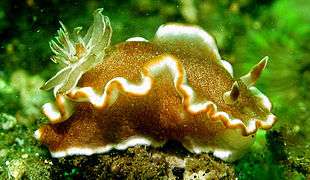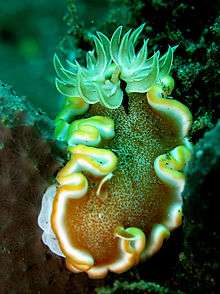Glossodoris rufomarginata
Glossodoris rufomarginata, commonly called white-margin sea slug or caramel nudibranch,[2] is a species of colourful sea slug, a dorid nudibranch, a marine gastropod mollusc in the family Chromodorididae.[3]
| Glossodoris rufomarginata | |
|---|---|
 | |
| Glossodoris rufomarginata | |
| Scientific classification | |
| Kingdom: | Animalia |
| Phylum: | Mollusca |
| Class: | Gastropoda |
| Subclass: | Heterobranchia |
| Order: | Nudibranchia |
| Suborder: | Doridina |
| Superfamily: | Doridoidea |
| Family: | Chromodorididae |
| Genus: | Glossodoris |
| Species: | G. rufomarginata |
| Binomial name | |
| Glossodoris rufomarginata | |
Description
Glossodoris rufomarginata has a commonly observed length of 35 mm (1.4 in) with a maximum length of 50 mm (2.0 in).[2][4] The background colouration of the entire body is whitish with the foot and the dorsal surface speckled with a dense coat of tiny red to orange-brown dots that give the impression at first glance that the animal is brown. The edge of the mantle is well developed and wavy with a broad white band with a red to orange-brown outer border. The foot has also a white external margin. The rhinophores and branchial plume are retractable[2] with a red to orange-brown colouration, a white median line on the rhinophores and a white highlight on the gill axes.
Distribution and habitat
This species occurs in the tropical waters of Indo-Pacific area. It has been reported from localities as far distant from one another as Tanzania in Africa and Mayotte in the Indian Ocean to the western Pacific Ocean. It occurs mainly from Sri Lanka to Polynesia and Hawaii.,[4][5] This nudibranch can be observed mostly on reef and rocky areas in sheltered or in exposed environments but with a preference for areas in the shade.[5]

Biology
Glossodoris rufomarginata is active in the daytime[5] and can be easily met on or in close proximity to its favourite food source which are some black sponges of the family Thorectidae,[2][6]
References
- Bergh, L. S. R. (1890). Die Nudibranchien des “Sunda-Meeres”. Malacologische Untersuchungen. In: Reisen im Archipel der Philippinen von Dr. Carl Gottfried Semper. Zweiter Theil. Wissenschaftliche Resultate. Band 2, Theil 3, Heft 17, pp. 873-992, pls. 85-89, page 943.
- Lamare, Véronique, Sittler, Alain-Pierre (2014). "Doris à Bord Roux". Données d'Observations pour la Reconnaissance et l'Identification de la faune et la flore Subaquatiques. Retrieved 18 December 2018.CS1 maint: multiple names: authors list (link)
- MolluscaBase (2018). Glossodoris rufomarginata (Bergh, 1890). Accessed through: World Register of Marine Species on 2018-12-18
- Bidgrain, P. Glossodoris rufomarginata South-west Indian Ocean Seaslug site, accessed 2018-12-18.
- Pittman, C. & Fiene, P., 2018. Glossodoris rufomarginata Sea slugs of Hawaii. Accessed 2018-12-18.
- Rudman, W.B., 2008 (Nov 18). Comment on Re: Glossodoris rufomarginata feeding by Marli Wakeing. [Message in] Sea Slug Forum. Australian Museum, Sydney.
External links
- Photos of Glossodoris rufomarginata on Sealife Collection